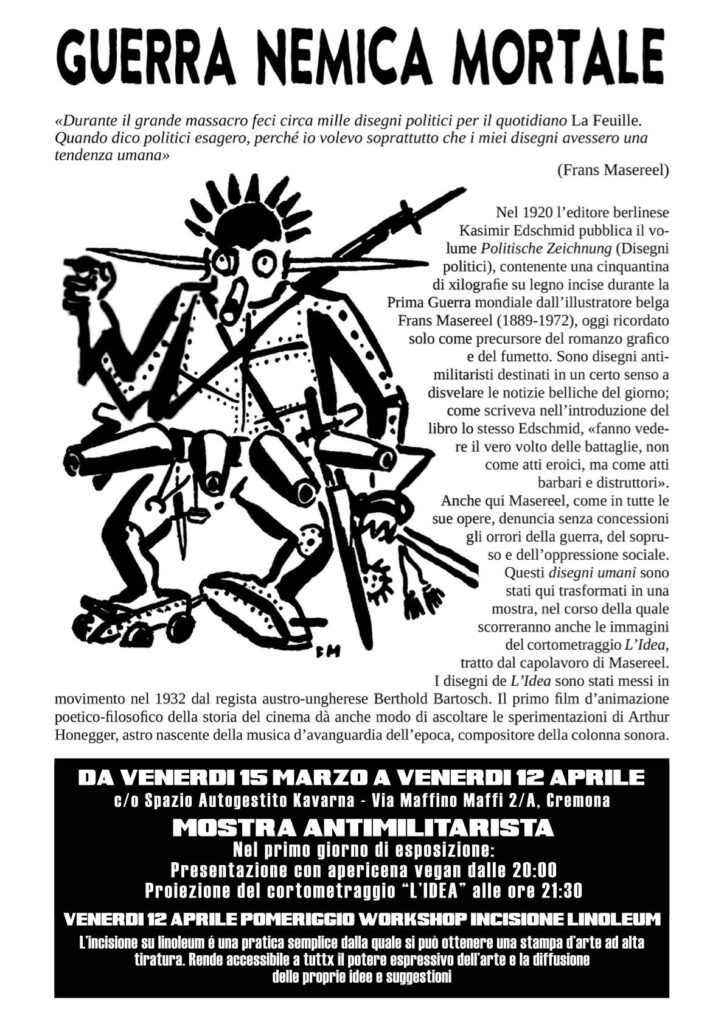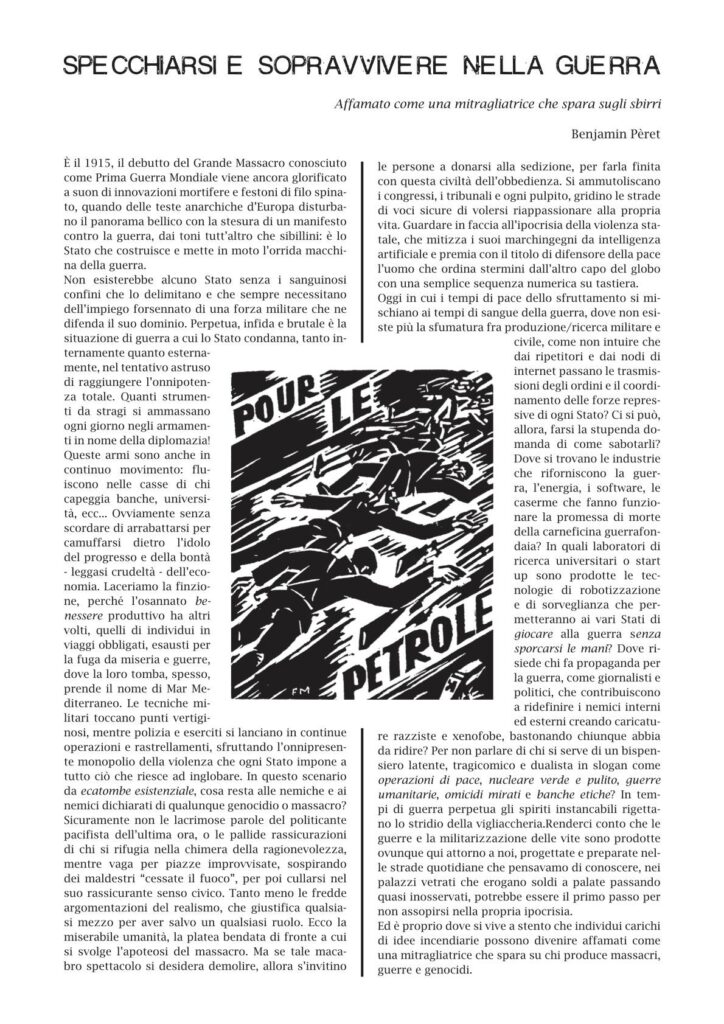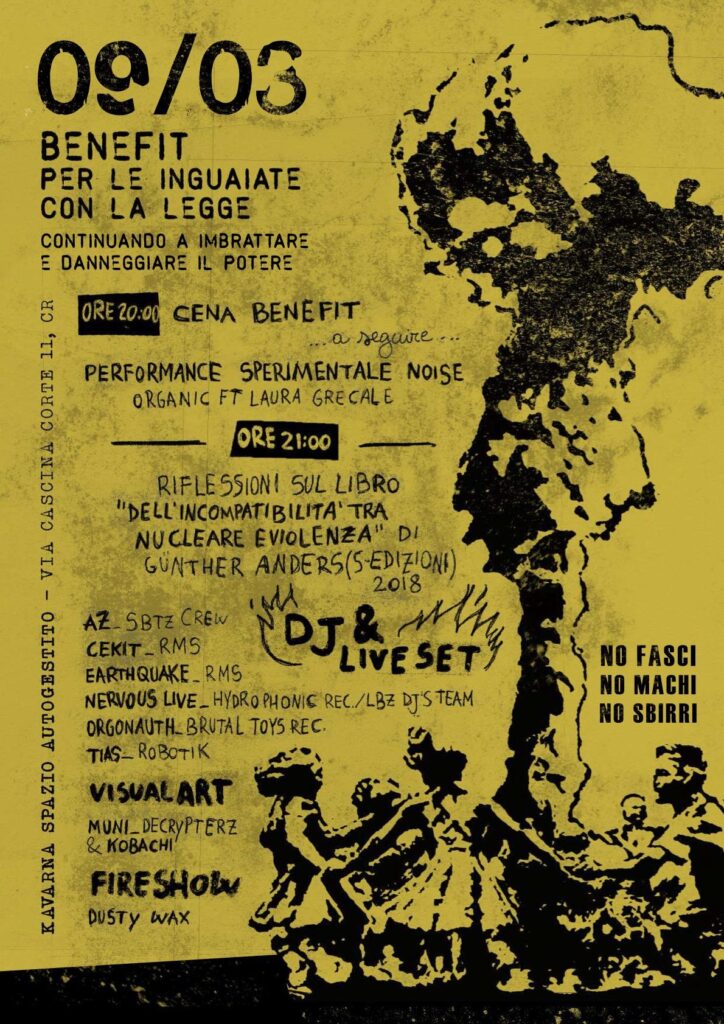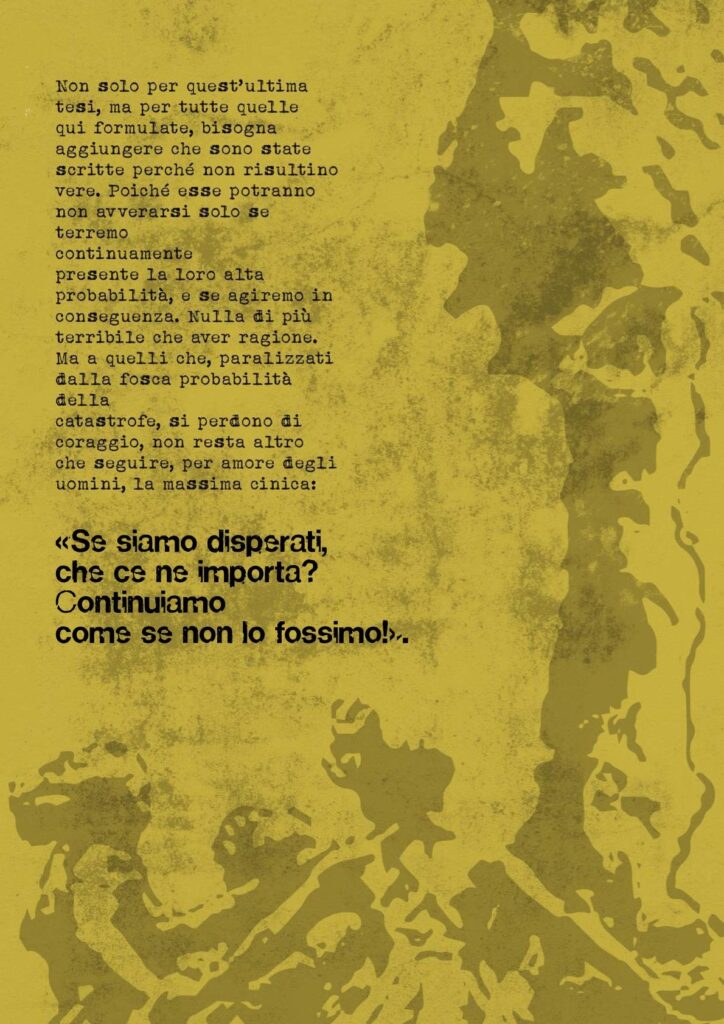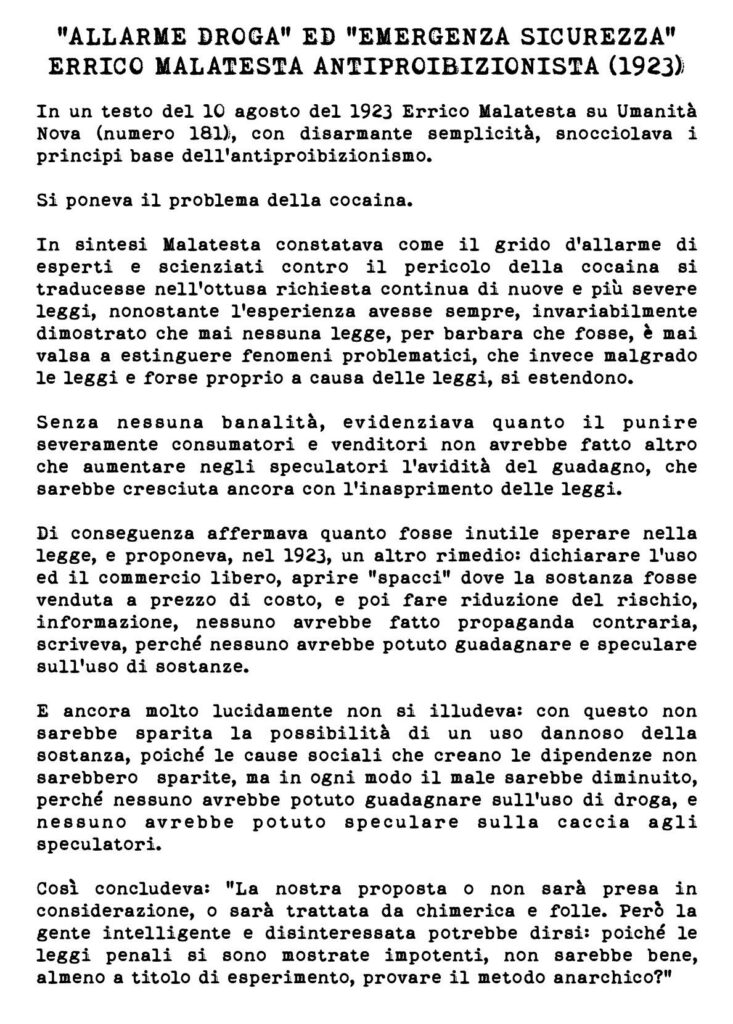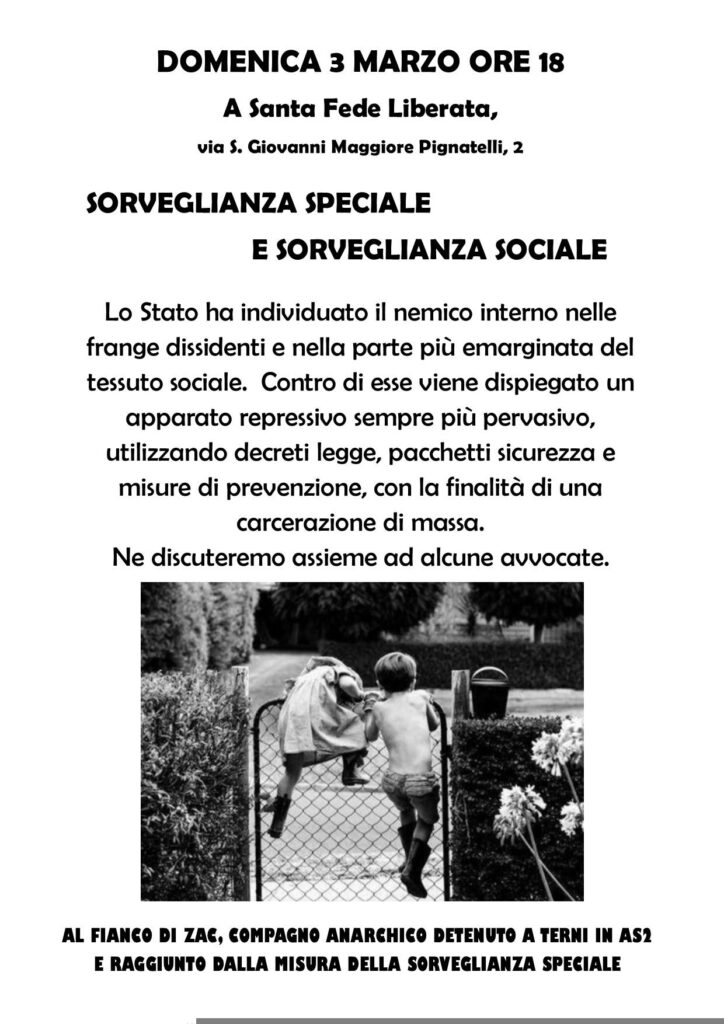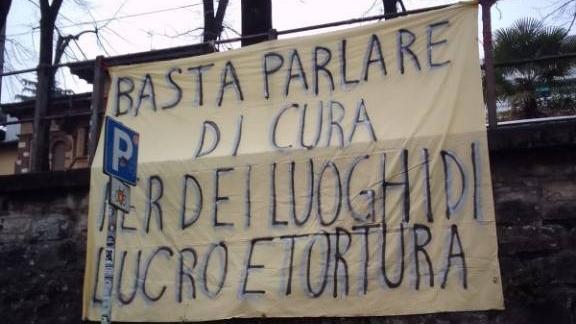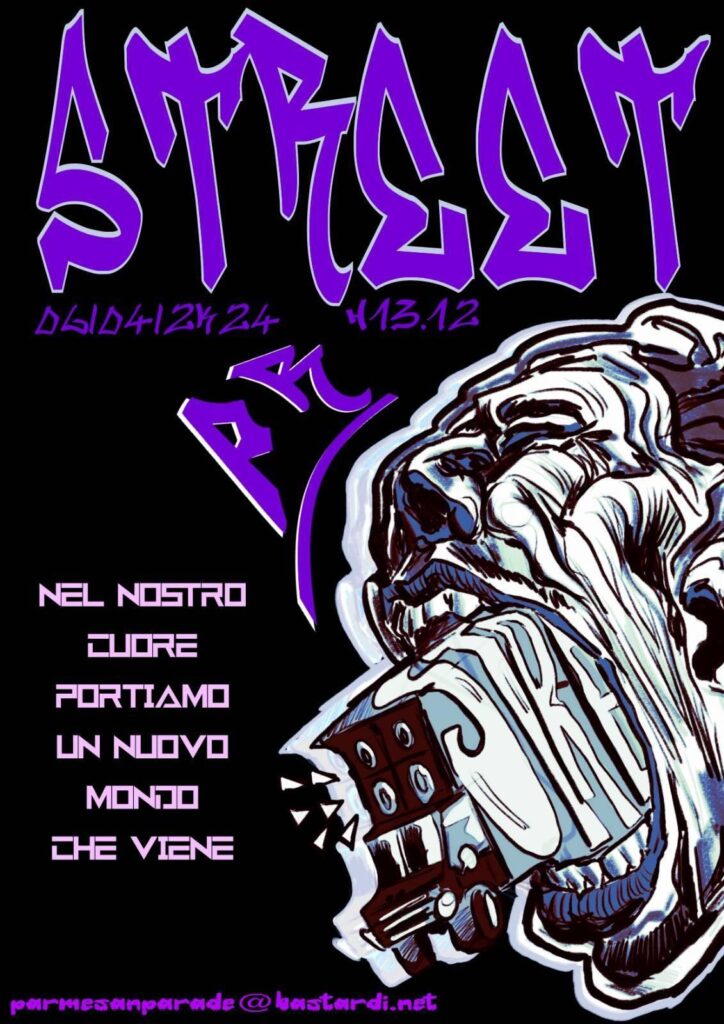Riceviamo e diffondiamo alcuni testi diffusi durante lo sciopero generale del 23 febbraio
– Palestina, aiutiamoli a casa nostra.
– Contro la militarizzazione della società
– Mappa campana delle complicità dello stato italiano nel genocidio palestinese.
– Sorveglianza sociale, sorveglianza speciale
PALESTINA: AIUTIAMOLI A CASA NOSTRA
Che sia in atto un genocidio dei palestinesi da parte degli israeliani è fuori dubbio, come è fuori dubbio che questo sia iniziato molto prima del 7 ottobre (almeno dal 1948) con l’appoggio diretto degli Stati Uniti e dei governi europei.
La mobilitazione che si è generata in Europa in sostegno alla Palestina ha sicuramente avuto un ruolo importante nel far emergere un racconto differente da quello propinato dai media oltre a rendere palese la distanza tra le politiche governative e il sentire comune della gente, tuttavia non hanno potuto rallentare la macchina di morte dello stato israeliano né tanto meno intaccare le relazioni che i vari governi hanno stretto o stanno stringendo con esso.
Per quanto riguarda l’Italia, innanzitutto, è stata tra i primi paesi a riconoscere il neonato stato ebraico nel 1949 e da allora i rapporti con Israele sono stati vivificati con frequenti scambi diplomatici e affari commerciali. Ha sostenuto fin dall’inizio il diritto alla difesa di Israele, si è astenuta nella risoluzione per l’immediato cessate il fuoco, ha tenuto incontri bilaterali con Netanyahu e ha impedito l’apertura dei corridoi umanitari. Inoltre, non ha mai esitato a fornire armi, infatti la marina israeliana monta cannoni della Oto Melara (Leonardo) con i quali bombarda quotidianamente la striscia di Gaza e, attraverso l’Eni, sfrutta giacimenti di gas in acque territoriali palestinesi.
Altro ruolo fondamentale lo stanno ricoprendo i mass media di regime che attraverso una narrazione a senso unico, che vede il popolo israeliano vittima dei feroci attacchi dei “terroristi di Hamas”, tentano di creare le condizioni etiche che possano giustificare l’annientamento della popolazione palestinese.
Siamo stanchi della quotidiana conta dei morti a Gaza, della retorica dell’antisemitismo che tenta di bloccare qualsiasi forma di dissenso verso lo stato israeliano, dei benpensanti ottusi che vedono in Israele un avamposto democratico in un territorio popolato da “feroci barbari”, come siamo stanchi di ascoltare una propaganda ad uso di decerebrati che parla di bambini decapitati, stupri di massa e massacro di civili inermi israeliani.
Non siamo disposti a tollerare ulteriormente questa situazione. Coscienti della difficoltà di aiutare materialmente la popolazione di Gaza e della Cisgiordania nella loro terra, possiamo e dobbiamo intraprendere dei percorsi di lotta radicale che mettano in luce le responsabilità criminali del governo italiano, oltre che tentare di bloccare i meccanismi, basati sul mero interesse economico e strategico, che alimentano questo stato di cose.
Bloccare la macchina tecnoindustriale che lavora nella produzione di strumenti civili e militari oltre che i progetti che varie università italiane portano avanti con aziende israeliane, ribaltare la narrazione dei pennivendoli di stato è possibile oltre che necessario.
Anarchici/e per la resistenza palestinese
Testo in PDF
CONTRO LA MILITARIZZAZIONE DELLA SOCIETA’
Militarizzazione significa ampliare il campo dell’azione militare, tanto in forma teorica quanto in forma concreta in un territorio e nella società, ed è quello che negli ultimi anni stiamo vivendo in forma sempre più evidente.
I recenti conflitti dall’Ucraina al genocidio che Israele sta attuando in Palestina e i conseguenti effetti in medio oriente, passando per altri conflitti accesi ma meno conosciuti e presenti nei media, hanno spinto gli Stati ad armarsi in forma sempre maggiore. Per diversi paesi occidentali in questi anni gli investimenti bellici sono cresciuti raggiungendo livelli che non si vedevano dalla fine della guerra fredda. Basti pensare che l’Italia spende mediamente 74 milioni di euro al giorno in spese militari e che queste cifre sono considerate ancora poco dagli alleati della Nato.
Questa corsa agli armamenti, non si manifesta solo attraverso la compravendita di armi e i conflitti in paesi “lontani”, ma si esercita anche nei nostri territori e nelle nostre vite, contro i nemici interni, che sono di volta in volta i derelitti più sacrificabili in nome della sicurezza: poveri, migranti, dissidenti.
Qui a Napoli è da anni che lo Stato risponde a qualsiasi problema di natura sociale aumentando la presenza di polizia e militari nelle strade, basti pensare all’operazione Strade Sicure che dal 2008 prevede una massiccia presenza di pattuglie che ormai nell’indifferenza più totale della popolazione controllano strade e quartieri della città.
Una grande salto in avanti in questo senso è stato fatto durante la pandemia da Covid-19, di nuovo nell’indifferenza della maggior parte, il governo ha disposto polizia e militari nelle strade mentre terrorizzava con una funzionale propaganda di guerra chiunque disertasse dalla linea dettata.
Un’altra forma in cui la militarizzazione dei territori si manifesta è nell’investimento in infrastrutture che hanno come scopo quello di facilitare la mobilità per le truppe e gli armamenti. Tentativo cioè di adattare la geografia della penisola allo scacchiere di guerra globale, esempio di questo ne è, fra gli altri, la costruzione del ponte sullo stretto, che come è stato appurato, dovrebbe rientare nel Trans European Transport Network TEN-T il cui scopo dichiarato è quello di creare una rete in grado di soddisfare “un piano di azione sulla mobilità militare 2.0”
La volontà dello stato di portare la disciplina di guerra ovunque ha trovato un grande laboratorio nelle scuole e nell’università. Da un lato sempre più scuole indottrinano giovani menti alla disciplina militare invitando militari a mettersi in cattedra. Dall’altro le caserme diventano sempre più luogo ideale per portare bambine e ragazze in gita. A spianare la strada a questo processo, l’uso sempre piu’ normalizzato del linhuaggio bellico nella vita quotidiana.
La questione del sapere e della ricerca universitaria funzionale alla guerra è poi un grande tema.
Infatti il doppio uso delle tecnologie e delle ricerche prodotte dalle università in ambito civile che poi vengono trasmesse all’ambito militare e viceversa è una grande questione aperta dai tempi della bomba atomica. Il fatto che le università collaborino con industrie belliche, come sempre di più sta succedendo, non solo permette una maggiore permeabilità nello scambio di ricerche fra civile e militare, ma contribuisce ad una sempre maggiore legittimazione del campo militare.
Il fatto che la militarizzazione permei la societa’ civile e la corsa agli armamenti sia sempre piu’ evidente rendono chiaro quanto uno scenario di guerra alle nostre latitudini sia sem- pre piu’ possibile.
FUORI LA GUERRA DALLE UNIVERSITA’, DALLE SCUOLE, DAI TERRITORI E DALLE NOSTRE VITE! LA GUERRA E’ OVUNQUE E CONTRO TUTTI, ESCLUSO CHI NE TRAE PROFITTO… QUINDI GUERRA ALLA GUERRA!
Testo PDF
Lo stato italiano è complice di Israele nel genocidio palestinese. La guerra che vediamo in televisione si produce qui.
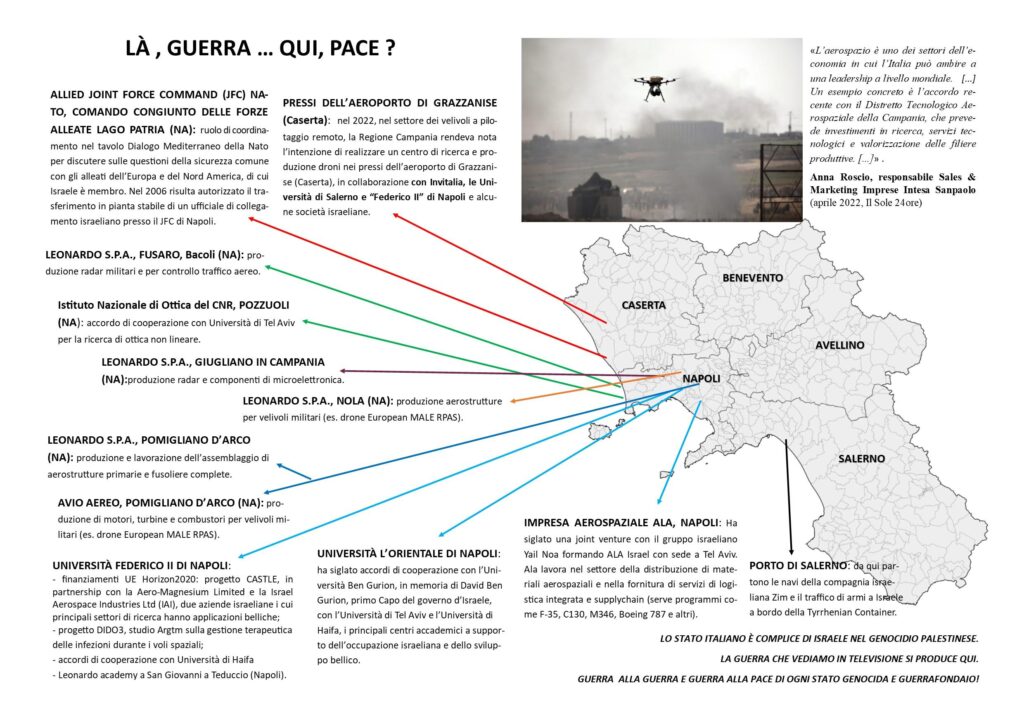
SORVEGLIANZA SOCIALE E SORVEGLIANZA SPECIALE
A dicembre il tribunale di sorveglianza di Napoli, su richiesta firmata dal questore di Napoli Maurizio Agricola, ha disposto l’applicazione della misura di sorveglianza speciale per Zac (ora prigioniero nel carcere di Terni) per due anni e sei mesi con le seguenti restrizioni: di non allontanarsi dall’abitazione senza preventivo avviso dell’autorità di sorveglianza, di non uscire prima delle 7 e non rientrare dopo le 20, di non associarsi “abitualmente” a persone condannate o preposte a misura di prevenzione o sicurezza, di non accedere a esercizi pubblici e di pubblico trattenimento, vivere onestamente rispettando le leggi, non detenere né portare armi, darsi alla ricerca di un lavoro, non partecipare a pubbliche riunioni, di portare sempre con sé la carta di permanenza, di presentarsi ogni domenica, o comunque a ogni invito, all’autorità preposta alla sorveglianza. A ciò si aggiunga una cauzione di 3000.00 euro da versare come garanzia, ma frazionabile in cinque comode rate.
La misura sarà eseguita non appena Zac uscirà dal carcere, a prescindere dall’esito del processo per 280 bis e 270 quinques, che intanto continua.
Ad oggi, la guerra contro il nemico interno si è sovrapposta irrimediabilmente a quella contro il nemico esterno, in un unico movimento per l’accumulo di predominio politico, economico e culturale che va innanzitutto a svantaggio delle popolazioni e degli oppositori.
In questo quadro l’accorpamento della magistratura antimafia e antiterrorismo (2015) ha generato una macchina strapotente che si autoalimenta con sempre nuove inchieste e mezzi a disposizione per sorvegliare sempre più persone o far credere di farlo, con l’obiettivo di instillare la paura e fare il vuoto intorno a chi viene colpito più direttamente.
Contro ogni distinzione tra colpevoli e innocenti, che è puro arbitrio dell’inquisizione democratica, sostenere le ragioni della rivolta e le identità messe sotto attacco, è una questione di autodifesa collettiva. Gli strumenti repressivi sempre più duri che vengono usati contro determinate categorie di persone sono destinati ad espandersi. L’ampliamento del regime del 41 bis, la storia recente dello strumento repressivo del 270 (associazione sovversiva), l’imputazione di Zac per 270 quinquies (autoaddestramento), il pacchetto sicurezza, il decreto Caivano, l’estensione della sorveglianza e della carcerazione a tutti i livelli, ne sono un esempio. Su questa stessa scia, i sindacati autorganizzati vengono accusati di associazione a delinquere, la lotta dei disoccupati organizzati diventa estorsione, gli scontri in strada puniti con l’aggravante camorristica, le pubblicazioni o gli striscioni censurati con l’accusa di istigazione a delinquere o apologia di terrorismo.
Anche l’estensione delle misure di prevenzione e del dispositivo della “sorveglianza speciale” – storicamente usate per punire poveri, briganti e antifascisti – è una delle tante conseguenze della fusione di apparati antimafia e antiterrorismo e della necessità di equiparare l’armamentario di guerra contro la criminalità organizzata e quello (mediatico, giuridico, linguistico) contro i dissidenti. Non è un caso che nell’odierno stato di emergenzialità permanente queste misure vengano richieste e elargite automaticamente e parallelamente all’accusa di terrorismo – come nel caso di Zac – o anche ben prima. Basta essere costretti in una delle categorie costruite, col linguaggio e col diritto, come “socialmente pericolose”, per vedere le proprie residuali “libertà”, già di per sé forme illusorie del sistema democratico, ulteriormente ristrette dalla sfilza di obblighi e divieti prescritti dalle misure di prevenzione. Questo sistema è storicamente espressione di una radicata cultura del sospetto e della tendenza, fin dalla colonizzazione del Sud Italia, a trasformare le questioni sociali, gli ideali e le lotte in problemi giudiziario-criminali.
Fino ai nostri giorni, quando l’obbligo di dimora, il domicilio coatto, il coprifuoco, il divieto di frequentare luoghi pubblici e di intrattenimento, che sono l’armamentario dispiegato dalle misure di prevenzione, sono stati oggetto di una sperimentazione di massa in tempi di guerra contro un nemico invisibile, quando il terrorista era un virus, e tutti indiscriminatamente, dovevano mettersi al riparo seguendo le regole di distanziamento sociale, umano e politico.
La morale securitaria che connota il XXI secolo e il terrorismo di Stato che opera attraverso l’apparato mediatico e giudiziario antiterroristico porteranno all’estensione su scala sempre più ampia di questi strumenti già impugnati contro gli oppositori del passato, grazie all’indeterminatezza costitutiva della norma e all’attuale momento storico. Tradendo i presupposti dello stesso (raccapricciante) diritto borghese, nato sul principio (comunque di impossibile applicazione se laddove c’è Stato non c’è libertà) che il corpo dovesse restare “libero” fino all’accertamento in sede processuale di una presunta colpevolezza (che non è già vero nel caso della carcerazione preventiva), le misure di prevenzione avvinghiano alle loro catene di carta intere categorie di persone senza alcun bisogno di processare degli atti come reati, perché a essere “rea” è già solo la personalità, l’ambiente, la condotta, l’idea. Questi dispositivi di psicopolizia, del resto, non sono volti a punire “reati”, ma a evitare che possano verificarsi, perciò impongono sequele di processi alle intenzioni, o meglio, ai pensieri potenzialmente trasformabili in atti… prima che si trasformino in atti. La sorveglianza speciale, quindi, è potenzialmente elargibile a chiunque, persino (si veda il decreto Caivano) a degli adolescenti. Un mezzo strapotente.
La criminalità organizzata di Stato che ha ipotecato le nostre vite al capitale sembra avere campo sempre più largo per reprimere il dissenso e per poter eseguire il prelievo necessario alla ristrutturazione capitalistica in corso, resa possibile dalla transizione digitale. Questa neoschiavitù, in cui ogni corpo è diventato una miniera da cui estrarre dati, è la più infame delle estorsioni.
Ma una cosa è certa. Quando pandemia, guerra e “transizione” digitale richiedono una sorveglianza sempre più estesa e la rendono possibile affiancando le catene di carta che ci legano al controllo poliziesco-giudiziario con le catene di fibra ottica che ci connettono alla rete del controllo elettronico, diventa sempre più visibile e tangibile quanto l’intera società sia ora più che mai un carcere a cielo aperto. Tra strumenti di carcerazione preventiva e luoghi di carcerazione punitiva, la distinzione, benché concreta, diventa sempre più sfumata nella testa di quanti vivono con insofferenza la proliferazione di catene multiple, e di quanti hanno come orizzonte la libertà.
La repressione poliziesco-giudiziaria selettiva contro anarchici e dissidenti, e la repressione culturale e digitale contro intere popolazioni si somigliano sempre più nei fini quanto nei mezzi, per un mondo di deradicalizzati da memoria, personalità e idee. In un mondo diviso da sempre più sbarre fisiche e digitali, chi potrà dire di non essere un sorvegliato speciale?
IL FRONTE INTERNO DELLA GUERRA
Questa società non ha più nulla da offrire se non malattie, morte, guerre.
E ottuso realismo politico, il più meschino nemico dei sogni. La vittoria del realismo contro l’utopia cercherà sempre più di far quadrare i conti in un’equazione senza scampo, di farci credere che la vita in ogni suo aspetto è totalmente sotto vigilanza, che il controllo totale può esistere a dispetto di ogni imprevisto.
Dalla fine della seconda guerra mondiale, la ghigliottina nucleare sospesa sulle nostre teste è stata un attacco senza precedenti alle possibilità di autodeterminazione di popoli e individui, perché la morte collettiva è diventata un bottone da premere. Un ricatto senza se e senza ma.
Oggi, l’intelligenza artificiale che sta per pervadere ogni infrastruttura sociale, economica e politica è una rivoluzione senza confini, se non quelli che le nostre coscienze e mani sapranno porre, perché finirà per eliminare anche la necessità ultima dell’operatore umano che preme quel dannato bottone. Al suo posto, un banale algoritmo. Quello stesso algoritmo che in un futuro prossimo si sostituirà nelle aule di tribunale al meccanismo già diabolico delle (im)perizie tecno-scientifico-industriali (un vero e proprio business) che ad oggi decide della libertà di migliaia di persone incarcerate.
È davvero questa la banalità del male, un insieme di ripetitive, automatiche e cieche procedure tecniche che attraverso software di elaborazione dei dati secondo parametri arbitrari pretendono di costruire verità inconfutabili in questa parte del mondo e massacri altrove. Se non vogliamo che in un domani non troppo remoto sia un algoritmo a decidere della vita e della libertà, è necessario attaccare il paradigma tecno-scientifico-industriale che domina tanto nella società, nelle aule di tribunale e sui campi di guerra, col suo ventaglio di mezzi (dalla videosorveglianza, alla videoconferenza, ai droni).
Più il male è banale, ancora più banale dell’impiegato burocrate, banale quanto una macchina robotica, più si cercherà di banalizzarlo: l’intelligenza artificiale, in fondo, è solo una soluzione tecnica ai problemi dell’umanità – non importa quanto questi siano il prodotto di scelte tecniche passate. E poi permetterà di curare malattie incurabili, di vincere la guerra, di costruire città più sicure e funzionali alla frenesia del nostro tempo. Non importa quanto i ritmi del lavoro e della competitività diventeranno insostenibili per gli esseri umani che non vorranno collaborare, o peggio, assimilarsi alla macchina. Non importa quanto la creazione di immagini false ma assolutamente verosimili ci renderà totalmente incapaci di informarci e irrimediabilmente diffidenti verso le nostre possibilità di comprendere qualcosa del mondo e di intervenire su di esso, azzerando ogni prospettiva che guardi al futuro e mettendoci all’angolo con la sensazione di essere caduti nella trappola di un controllo totale. È contro questo realismo che rischia di imporre una volta per tutte la più orribile delle distopie, che è fondamentale andare al sodo, selezionando le sole informazioni che contano davvero per metterci di traverso a un futuro fatto di isolamento, infelicità e ingiustizia.
L’accumulazione capitalistica di miliardi dati per far funzionare le tecnologie che servono a combattere la guerra, nel dominio di poche multinazionali che stringono accordi con le università finanziandone la ricerca, sarebbe impensabile senza i data-center localizzati che li conservano. Una guerra per il controllo delle materie prime e delle risorse che servono a realizzare le tecnologie che governeranno il futuro non può essere combattuta senza fabbriche di armi, senza le infrastrutture che servono al flusso di informazioni e uomini; senza la ridefinizione giornalistica e accademica dei nuovi nemici interni e esterni; senza il pacifico consenso del fronte interno dell’opinione pubblica all’economia di guerra che ci hanno imposto col rincaro dei generi primari (cibo e energia); e alla cultura dell’odio tra sfruttati.
Perciò, non possiamo avere paura di estendere l’idea che abbiamo della guerra. È necessario prendere atto dell’impossibilità di distinguere la guerra al nemico interno dalla guerra contro il nemico esterno, tra i tempi di guerra e i tempi di pace, così come tra produzione e ricerca tecnologica militare e civile, perché fino a che esisterà, lo Stato è e sarà sempre uno strumento di guerra: contro altri stati, contro popoli e territori colonizzati, contro la natura e gli individui in rivolta. L’accumulo e il mantenimento di potere nelle mani di pochi a danno dei più è una guerra permanente combattuta quotidianamente con tutti i mezzi necessari, dallo sfruttamento senza confini sui luoghi di lavoro alla cascata di bombe sui cieli di interi territori. Il pericolo di distruzione dei posti di lavoro legato all’intelligenza artificiale è direttamente proporzionale al pericolo di distruzione materiale della sua applicazione alle tecnologie militari. Questo stato di guerra a tutti i gradi si esprime all’interno dei confini nazionali con la riabilitazione del lavoro minorile per mezzo dell’alternanza scuola-lavoro, con la militarizzazione dei quartieri, delle scuole, del conflitto sindacale. Per quanto non sia mai esistita una scuola neutrale, la sua attuale militarizzazione le rende sempre più luogo di arruolamento forzoso, di uniformazione per accettare l’esistenza dell’uniforme, della forza armata che tiene l’umanità divisa tra oppressi e oppressori e che si oppone a ogni tentativo di liberazione.
Mentre piovono bombe dai cieli d’Israele, da questa parte del mondo siamo bombardati dalla frenesia violenta di un flusso di notizie in cui è impossibile distinguere ciò che importa. La nostra coscienza diventa muta davanti a questa difficoltà di comprensione e di immaginazione, il nostro sguardo cieco a ogni prospettiva futura. Come possiamo ripartire dall’utopia per combattere la resa a questo destino dominato dalla razionalità del meno peggio? Il realismo politico vuole intimidirci col ricatto che due o tre guerre piccole contro gruppi terroristi e Stati canaglia siano meglio di una grande guerra da cui si potrebbe anche uscire sconfitti. In parte ci sono già riusciti, paralizzando ogni movimento di solidarietà internazionalista tra oppressi che potesse ostacolare l’invio di armi e imporre dal basso il cessate il fuoco, con l’operazione mediatica che ha beceramente assimilato la resistenza ucraina alla lotta partigiana contro il nazi-fascismo.
Ma se continuiamo a sentirci “al sicuro” perché “tanto la guerra è lontana”, abbiamo fatto davvero male i conti. L’assassinio, o, ancora peggio, il suicidio di ogni etica non conforme alla logica realista di un mondo dominato da guerra e intelligenza artificiale significa la vittoria di una logica di conquista e mantenimento del potere di pochi, in fondo talmente irrazionale, da rischiare il massacro dell’intera umanità.
Come soli antidoti: disfattismo rivoluzionario e solidarietà a chi si ribella! rendendo impossibile la percezione e la realizzazione di un sistema di guerra e controllo totale.
Testo PDF
